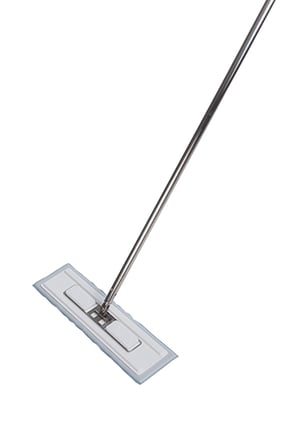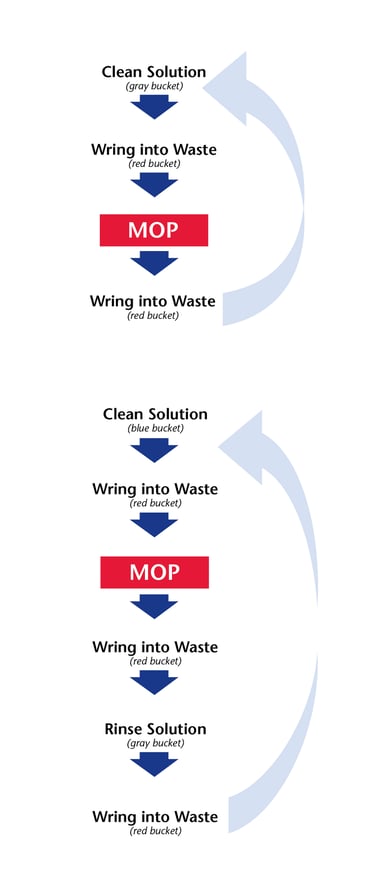Mopping Floor Surfaces: Coverage, Buckets and Validation
Whether for removing contaminants, such as soil, residues, or errant product/process material, or uniformly applying disinfectant and other solutions to floors, floor mopping is a essential task in the cleaning maintenance of any controlled environment. Unfortunately, it is also commonly done incorrectly and inefficiently, leading to unreliable and less effective results, higher costs, and quality issues for cleaning controlled environments.
A clear understanding of best practices that have been found to provide the most consistent desired outcomes in floor cleaning is needed to make informed decisions that improve cleanroom maintenance while controlling costs.
The single most important fact to understand is that the methods and materials used, and work well enough, in cleaning the floors of offices, restaurants, and warehouses are not well suited to achieving and maintaining the results required of most floor and wall surfaces in controlled environments. The most critical reason for this is that when cleaning floors in most controlled environments, the requirement is to control and remove contaminants that are invisible to the naked eye. Such a task can only be accomplished through the consistent and methodical use of tools and materials that are appropriate to the needs of the cleanroom environment and the processes in it.
Mopping Coverage
One of the most commonly asked questions regarding floor mopping in controlled environments is how much floor area a given mop can clean. While the desire for a simple answer to the question is certainly understandable, it is also realistically impossible. There are just too many variables, unique to any specific controlled environment, that have significant impact on the answer to this question. But users continue to ask the question, and those asked attempt to provide an estimate of coverage that is an overly broad guess at best.
It should be clearly understood that any estimate regarding how much floor area can be cleaned by any mopping system is just that - an estimate; based on assumptions of average contamination loads and floor conditions typically observed at end users’ facilities in a variety of industries. Obviously, there is no way to make an accurate estimation of coverage without understanding the variables that determine actual coverage in fact, and knowledge of these variables for the specific facility to be cleaned.
The single most important factor in determining mop coverage is the contamination load (type and quantity of contaminants) on the floor to be cleaned. Such contaminants can be viable or nonviable in nature, and the concern over them depends on the nature of the processes contained within the rooms being cleaned. The contamination load also directly influences many other fundamental choices such as cleaning protocols, cleaning frequency, and the materials and solutions used. This contamination load depends on many factors such as:
- Operations and processes within the room
- Materials brought into the room and how they are handled once inside
- Number of operators in the room
- Gowning requirements and operators’ adherence to correct gowning and behavior protocols
- Maintenance activities and the behavior of maintenance personnel while in the room
- Other ancillary contamination control measures such as tacky mats, contaminant source control, cleanroom access control, cart protocols, etc.
- Overall cleanroom condition
Additionally, there are other variables that also affect mop coverage, including:
- The type and condition of the flooring surface itself
- The frequency of floor cleaning, and the thoroughness with which it is done
- Frequency of change of cleaning materials (tacky roller covers currently) - most cleaning materials (tacky rollers included) typically are not changed until well after they no longer are removing contaminants
For control of microorganisms in controlled environments, identification of the specific species of organisms is also very important and must first be determined through Environmental Monitoring. They then need to be taken into account when considering the contamination load and how best to clean the floor surfaces.
Single and Multiple Bucket Systems
Obviously one of the purposes of mopping a floor is to remove soil and other contaminants from the floor and out of the environment. When done properly with a system that is appropriate to the specific needs of the room to be cleaned, floor mopping is efficient and effective, regardless of the specific type of mop system used (flat mop, string style, etc.). However, all parts of the mopping system must work together.
Many cleaning personnel continue to use a single bucket and mop wringer for floor cleaning. This is an all-too-common practice, and is very poor practice. With this practice, fresh cleaning solution is placed in the single bucket, and the mop wringer is positioned to drain into this same bucket. In use, the mop is saturated with solution (“recharged”) by immersion into the single bucket, wrung out into the same bucket, and used to mop an area of floor. After mopping, the mop is then “rinsed” in the same single bucket, wrung out into the same bucket, and then used to mop another area of floor. This process is repeated until the entire floor has been mopped.
In the single bucket protocol, it is easy to understand that the cleaning solution, initially fresh at the start of the mopping cycle, very quickly becomes loaded with contaminants that have been mopped from the floor, then “rinsed” into and wrung into the single bucket. Since the mop is “recharged” with solution from the same bucket that is used for collecting the waste solution (wrung from the mop after mopping the floor each time), the mop gets progressively dirtier with each mopping cycle, and the contaminants that were thought to be removed from the floor are simply re-deposited back onto the floor. When repeated with every mop cycle, day after day, the floor becomes visibly dingy because soils and other contaminants (including dirty “cleaning” solution residue!) have never really been removed from the floor.
The second main use for mops is for the application of disinfectants, importantly for the application of disinfectants, the use of a single bucket for mopping results in rapid and significant degradation of the efficacy of the disinfectant solution as mopping progresses, since the organic soils picked up from the floor, concentrated in the single bucket, neutralize the disinfectant very quickly.  In a two-bucket system and protocol, the mop wringer is placed over one of the buckets, dedicated as the “waste” bucket, and the mop is NEVER put into that bucket. The second bucket is used to hold the cleaning solution, or rinse water if a rinse protocol is followed. The mop then is placed ONLY into this bucket to “rinse” and recharge the mop with cleaning solution. Use of a two-bucket mopping protocol will provide significant immediate and long term benefits, including:
In a two-bucket system and protocol, the mop wringer is placed over one of the buckets, dedicated as the “waste” bucket, and the mop is NEVER put into that bucket. The second bucket is used to hold the cleaning solution, or rinse water if a rinse protocol is followed. The mop then is placed ONLY into this bucket to “rinse” and recharge the mop with cleaning solution. Use of a two-bucket mopping protocol will provide significant immediate and long term benefits, including:
- Significantly cleaner floors, with no dingy appearance
- More consistent and reliable environmental control, including control of microorganisms, resulting in less risk to product quality
- More effective mopping for the time spent to clean the floors
- More effective cleaning and disinfectant solutions that are not depleted so quickly
- Cleaning solutions will be cleaner, longer, resulting in less solution used over time
- Longer life for mopping equipment
The addition of a third bucket to provide a dedicated mop rinse solution (either water or a dilute solution of disinfectant) extends all of the benefits of the two-bucket protocol. Three bucket protocol is considered an industry best practice as it minimizes the disinfectant solution from being contaminated and reduces the risk of reapplying contaminants.
As with any cleaning protocol, cleaning staff must be properly trained in best practice mopping protocols, including knowing when to replace the cleaning solution for the most consistent and effective results.
Validation
The preceding information regarding coverage and the use of single or multiple bucket mopping systems is applicable to floor cleaning in any controlled environment, but is especially important for cleaning and disinfecting floor surfaces in environments requiring control of microorganisms, such as pharmaceutical and medical device manufacturing. In these manufacturing facilities, most of which are regulated by the FDA (or EMA in Europe and CFDA in China), validation of a facility’s Standard Operating Procedures (SOP’s) is required, and the SOP’s are routinely audited.
Part of the audit process often involves justification of various SOP’s and review of the work and other studies used to establish the SOP’s. Floor cleaning in both non-sterile and sterile environments is often overlooked when conducting validation studies, but to neglect such study can create serious problems upon audit.
The methods for validating floor cleaning are essentially the same as for validating the microbial cleanliness of any other flat surface in the cleanroom. Typically, contact plates are placed at predetermined locations throughout a room, both before and after cleaning. The plates are then analyzed for reduction in colony forming units (cfu) in order to validate the floor cleaning protocols and materials. As with any validation study, complete records must be created and maintained.
By: Dave Nobile
